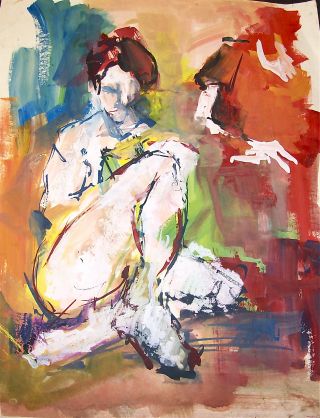
Health
The Trials of Art Therapy: An Introduction
Serving as an art therapist for a murder trial--the beginning
Posted August 23, 2013

An art piece used to assess the defendant
A man kidnapped his two children, murdered one and attempted to kill the other. The prosecution sought the death penalty. The defense team worked hard to avoid this sentence by exhausting all appropriate resources and strategies available. This included using the defendant’s own artistic creations. They believed the art the defendant created over his lifetime held answers that would assist in his defense. To get these answers, they contracted with an art therapist to assess the defendant and provide expert witness testimony on his artwork to determine if the man had a mental illness at the time of the crimes.
The art therapist concluded that the defendant suffered from a Schizoaffective Disorder at the time of his crime and presented this in court. Two other expert witnesses contracted by the defense, a psychiatrist and a psychologist, arrived at the same conclusion. This was significant because the conclusion derived from the art-based assessment was developed independently from the other two mental health professionals. Ultimately, the defendant received a sentence of 95 years.
This oft-used description of the book Art on Trial (Gussak, 2013) has stimulated intrigue into how art therapy was used for a capital murder defense trial. However, I am certainly not the first art therapist that has served the court system.
Forensic art therapy is “…the combination of art therapy with standard forensic procedure and protocol [which] produces a hybrid that is fundamentally investigative fact-finding, with clinical overtones” (Gussak, 2013, p.12). While art therapy is generally understood as a form of treatment, in this case, art therapy was used for its investigative ability, to assess the art and provide information where words are not available.
In 1990 Safran, Levick, and Levine published the article, “Art therapist as expert witnesses: A judge delivers a precedent-setting decision.” Presenting the case in which an art therapist’s admissibility to provide evidence for an abuse case was brought before a judge, this article demonstrated how the education and assessment acumen for art therapists could serve the court.
Marcia Sue Cohen-Liebman, considered the leading forensic art therapist, is responsible for coining the term forensic art therapy and for developing its standard definition. She has been providing her assessment and investigative skills to aide children and victims in abuse cases in the court system for many years. In her work, she realized there were three advantages for using drawings in a forensic context:
- As interviewing tools, drawings are used in a supportive capacity in the investigation of legal matters
- In the capacity of charge enhancement, drawings provide contextual information that can contribute to the determination of charges as well as the identification of additional arenas to investigate
- Drawings as judiciary aids provide evidentiary material that is admissible in judicial proceedings (Cohen-Liebman, 2003, p.171-italics added)
Most forensic art therapists find themselves providing support for family, custody and child abuse cases. In the case presented in the book, I took a different role—instead of aiding a child victim, I helped the defense attorneys of an adult who murdered a child.
In 2006, I was contacted by a defense attorney and was asked to be a consultant for capital murder case (with the possibility of testifying in court). All I was told was the prosecution was seeking the death penalty and the defense team was considering the presence of a mental illness. Most essential, the defendant had a long history of creating art. Although they had never worked with an art therapist before, the defense attorney believed that they needed someone to determine if the art they collected—over 100 images—revealed a psychiatric disorder. I was not given any specifics of the case, nor was I told what outcome they were looking for.
I must confess, I was simultaneously excited and cautious that a defense attorney would contact me to provide assessment and testimony. Here was somebody who understood what I already knew—that art therapy was a legitimate and substantive investigative tool in uncovering a long-brewing mental illness, one that had not been diagnosed before. Conversely, I was cautious in that I was not sure how I felt about providing testimony for a murder defendant, especially after I discovered that this person had killed his child. However, I soon came to the realization—and made this clear to the defense team—that I would not testify for or against the defendant but rather I would testify solely on the art. Call this rationalization, call it acrobatic semantics, this mindset allowed me to sleep at night.
I was new to this experience in that had never served as an expert witness in criminal court hearings. I had spent many years working as an art therapist in prisons and juvenile facilities, working with aggressive and violent clients, and had conducted years of research investigating the effectiveness of art therapy in prison. While I had taught assessments for many years in universities, and had to justify my knowledge base, I had never testified in court on a client’s art. I was intrigued, and eventually, I agreed to do so.
Nevertheless, during the 2½ years I worked on the case, the formal elements of each art piece were meticulously assessed and deconstructed. The final analysis demonstrated that the defendant had an undocumented—but dominant -- mental illness. While I spent those years evaluating the art, the defense was hard at work building a defense for their client, including securing my expert witness status. I also met with the defendant on two separate occasions to review his artwork and administer art-based assessments, and I took part in a deposition conducted by the deputy district attorney. These experiences culminated in the hearing before the judge, which included a testimony, cross-examination and redirection that lasted a few hours. Ultimately, what was presented to the court was that the formal elements (as opposed to the symbolic meaning of the imagery) revealed a Schizoaffective Disorder . The psychiatrist and psychologist who testified earlier in the week verified this diagnostic profile. I had not spoken with either mental health professional prior to delivering my testimony.
This experience led to the theory that using art as evidence in a murder trial is beneficial:
- Art is a viable assessment tool that can ascertain mental health status at the time of both the crime and trial or hearing
- Art can be used as a means to reveal and ascertain the truth of a defendant’s statements and information
- The display of art and the demonstration of artistic imagery can humanize a defendant (Gussak, 2013, pp. 176-178).
In future blogs I will explore each of these points. I will examine the assessment approach used for this case, specifically focusing on the formal elements of the images. In one upcoming blog I will detail the ethical, moral and legal considerations of providing testimony, will compare and contrast other cases in which other art therapists have served murder trials, and how the legal arena reacted to art therapists as expert witnesses. Upcoming blogs will explore the role of art therapy in forensic and correctional settings, including its benefits for these environments, the empirical research that demonstrates its effectiveness in both men and women’s prisons, and case vignettes that illuminate inmate and personal experiences. Finally, I will eventually present and discuss the art of serial killers. Stay tuned.
---
Addendum: I had a surprise at the American Art Therapy Association conference in Seattle WA, which I just had to add to this introductory blog. I was asked to lead a Master’s Supervision session on Forensic Art Therapy. I planned on about 20 attendees, a number that was consistent in other years I have led this session. The 20 chairs in the circle quickly filled up, and by the time the session began, there were another 60-75 additional attendees. The attendees’ experiences ranged from involvement with the courts and legal systems to working within various forensic and correctional arenas. Although overwhelming, the discussion was lively and exciting, and it was apparent the attendees were hungry for more information. Many were also surprised to learn that there were many people working in similar settings. I mention this to illustrate the growing field, and the awareness of the value that art, art therapy and art-based assessments can lend to forensics.
Cohen-Liebman, M.S. (2003). Using drawings in forensic investigations of child sexual abuse. In C. Malchiodi’s (Ed.) Handbook of clinical art therapy. New York, NY: Guilford Press.
Dissanayake, E. (1988). What is art for? Seattle, WA: University of Washington Press.
Gussak, (2013). Art on Trial: Art therapy in capital murder cases. New York, NY: Columbia University Press.
Safran, D.S., Levick, M. F.& Levine, A.J. (1990). Art therapist as expert witnesses: A judge delivers a precedent-setting decision. The Arts in Psychotherapy, 17. 49-53.
__
Footnotes:
Although this blog precludes my ability to include these drawings, the publishers of the book Art on Trial, Columbia University Press, created a dedicated website on which the images from the book are available for your viewing pleasure—they can be found at www.cup.columbia.edu/static/gussak-art-on-trial-images
Please note that while this blog relies on some common knowledge of art therapy, I won’t be spending a great deal of time providing general information about the field—there are other blogs that do so. This one, however, will explore specific art-based assessment issues, professional considerations in relationship to forensics, and treatment-focused attributes specific to related populations.



